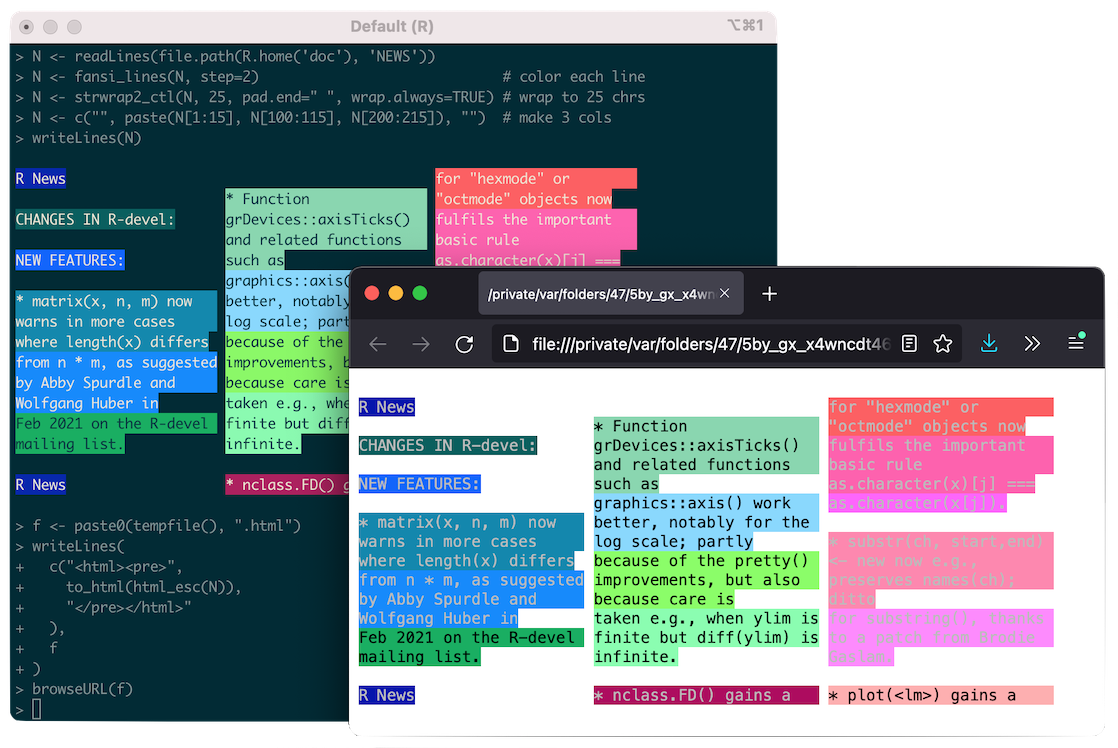Counterparts to R string manipulation functions that account for the effects of ANSI text formatting control sequences.
Many terminals will recognize special sequences of characters in strings
and change display behavior as a result. For example, on my terminal the
sequence "\033[42m" turns text background green:
The sequence itself is not shown, but the text display changes.
This type of sequence is called an ANSI CSI SGR control sequence. Most
*nix terminals support them, and newer versions of Windows and Rstudio
consoles do too. You can check whether your display supports them by
running term_cap_test().
Whether the fansi functions behave as expected depends on many
factors, including how your particular display handles Control
Sequences. See ?fansi for details, particularly if you are getting
unexpected results.
ANSI control characters and sequences (Control Sequences hereafter) break the relationship between byte/character position in a string and display position.
For example, in "Hello \033[42mWorld, Good\033[m Night Moon!" the
space after “World,” is thirteenth displayed character, but the
eighteenth actual character (“\033” is a single character, the ESC). If
we try to split the string after the space with substr things go wrong
in several ways:
We end up cutting up our string in the middle of “World”, and worse the
formatting bleeds out of our string into the prompt line. Compare to
what happens when we use substr_ctl, the Control Sequence aware
version of substr:
fansi provides counterparts to the following string functions:
substr(andsubstr<-)strsplitstrtrimstrwrapnchar/nzchartrimws
These are drop-in replacements that behave (almost) identically to the base counterparts, except for the Control Sequence awareness.
fansi also includes improved versions of some of those functions, such
as substr2_ctl which allows for width based substrings. There are also
utility functions such as strip_ctl to remove Control Sequences and
has_ctl to detect whether strings contain them.
Much of fansi is written in C so you should find performance of the
fansi functions to be slightly slower than the corresponding base
functions, with the exception that strwrap_ctl is much faster.
Operations involving type = "width" will be slower still. We have
prioritized convenience and safety over raw speed in the C code, but
unless your code is primarily engaged in string manipulation fansi
should be fast enough to avoid attention.
You can translate ANSI CSI SGR formatted strings into their HTML
counterparts with to_html:
It is possible to set knitr hooks such that R output that contains
ANSI CSI SGR is automatically converted to the HTML formatted equivalent
and displayed as intended. See the
vignette
for details.
This package is available on CRAN:
install.packages('fansi')
It has no runtime dependencies.
For the development version use
remotes::install_github('brodieg/fansi@development') or:
f.dl <- tempfile()
f.uz <- tempfile()
github.url <- 'https://github.com/brodieG/fansi/archive/development.zip'
download.file(github.url, f.dl)
unzip(f.dl, exdir=f.uz)
install.packages(file.path(f.uz, 'fansi-development'), repos=NULL, type='source')
unlink(c(f.dl, f.uz))
There is no guarantee that development versions are stable or even working. The master branch typically mirrors CRAN and should be stable.
- crayon, the library that started it all.
- ansistrings, which implements similar functionality.
- ECMA-48 - Control Functions For Coded Character Sets, in particular pages 10-12, and 61.
- CCITT Recommendation T.416
- ANSI Escape Code - Wikipedia for a gentler introduction.
- R Core for developing and maintaining such a wonderful language.
- CRAN maintainers, for patiently shepherding packages onto CRAN and maintaining the repository, and Uwe Ligges in particular for maintaining Winbuilder.
- Gábor Csárdi for getting me started on the journey ANSI control sequences, and for many of the ideas on how to process them.
- Jim Hester for covr, and with Rstudio for r-lib/actions.
- Dirk Eddelbuettel and Carl Boettiger for the rocker project, and Gábor Csárdi and the R-consortium for Rhub, without which testing bugs on R-devel and other platforms would be a nightmare.
- Tomas Kalibera for rchk and the accompanying vagrant image, and rcnst to help detect errors in compiled code.
- Winston Chang for the r-debug docker container, in particular because of the valgrind level 2 instrumented version of R.
- Hadley Wickham and Peter Danenberg for roxygen2.
- Yihui Xie for knitr and J.J. Allaire et al. for rmarkdown, and by extension John MacFarlane for pandoc.
- Gábor Csárdi, the R-consortium, et al. for revdepcheck to simplify reverse dependency checks.
- Olaf Mersmann for microbenchmark, because microsecond matter, and Joshua Ulrich for making it lightweight.
- All open source developers out there that make their work freely available for others to use.
- Github, Travis-CI, Codecov, Vagrant, Docker, Ubuntu, Brew for providing infrastructure that greatly simplifies open source development.
- Free Software Foundation for developing the GPL license and promotion of the free software movement.



